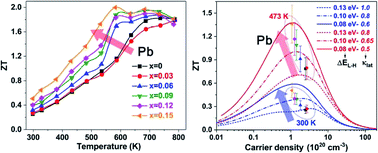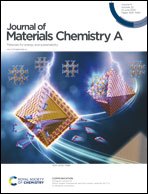Band convergence and carrier-density fine-tuning as the electronic origin of high-average thermoelectric performance in Pb-doped GeTe-based alloys†
Abstract
Band convergence and optimization of carrier density play significant roles in enhancing thermoelectric figure of merit (ZT). In this study, using combined experimental and computational studies, we have systemically revealed the electronic origin of high-average ZT in Pb-doped GeTe-based alloys. The intrinsic high hole-carrier density of GeTe is firstly reduced to a rough optimal range by Bi doping, and then the carrier density is finely tuned by Pb doping. The band convergence by Pb doping can maintain the relatively high power factor of GeTe-based alloys when the carrier density is reduced by Pb doping. Moreover, further reduction of lattice thermal conductivity and fine tuning of carrier density by Pb doping can maximize the ZT at corresponding carrier density, therefore realizing high-average ZT. A peak ZT of ∼2.0 at 573 K and an average ZT of ∼1.50 within 300–773 K can be obtained in Ge0.96(1−x)Pb0.96xBi0.08Te1.08 with x = 0.15. This work demonstrates the great positive effects of Pb for high-average ZT in GeTe-based alloys, and also provides a guide for the rational use of Pb.



 Please wait while we load your content...
Please wait while we load your content...